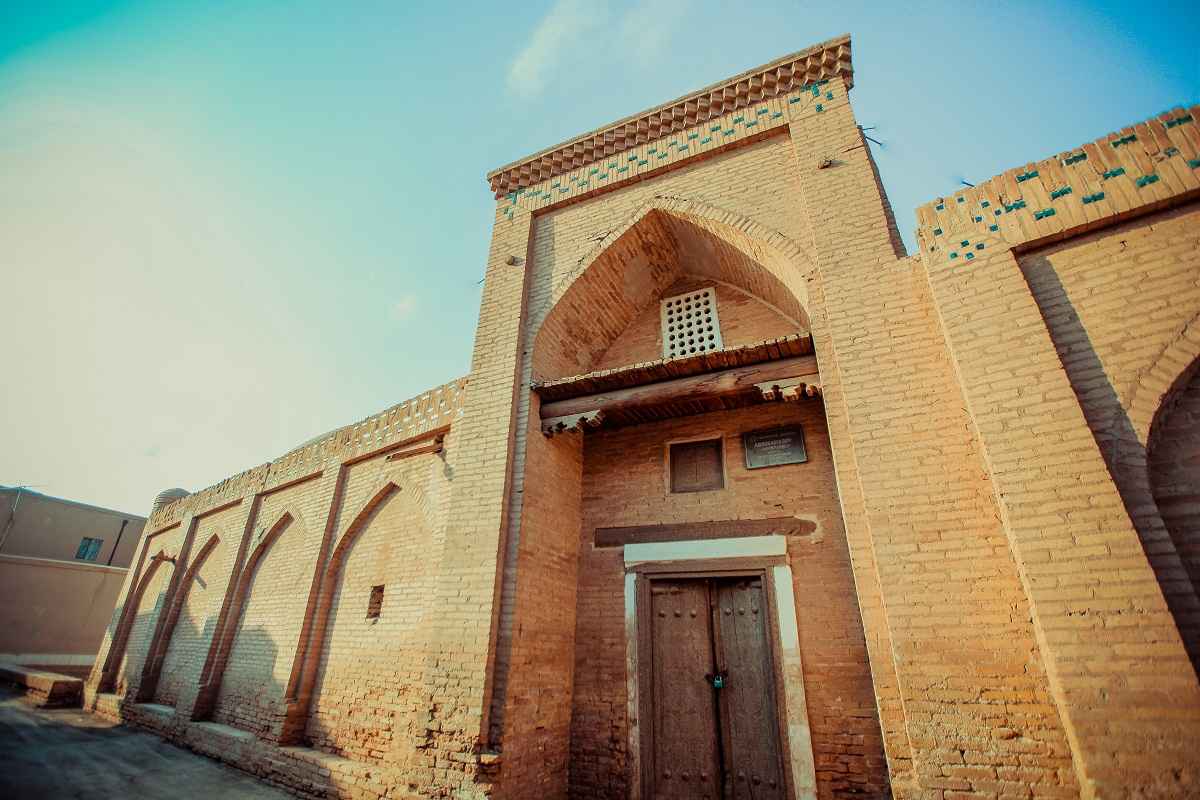Khiva - Abdurasulbay Madrasa

The Abdurasulbay Madrasah in Khiva – a masterpiece of late Islamic educational architecture
The Abdurasulbay Madrasah in Khiva, built in 1906, is an outstanding example of late Islamic educational architecture in Central Asia. It is located at the south-east corner of the Yar Muhammad Devon Mosque and was built with the financial support of Abdurasulbay, a nephew of the renowned poet, composer and translator Muhammad Niyaz Mirzabashi, known as Komil Khorazmi (1825-1899). Komil Khorazmi, an important representative of classical Uzbek literature and music, had himself studied at a madrasa in Khiva and was a pupil of the Agakhi school. He served as secretary and head of the chancellery of Muhammad Rahim Khan II, one of the most important rulers of Khiva in the 19th century, who was particularly committed to the promotion of culture and science.
Architectural features of the Abdurasulbay madrasah
The medrese is characterised by its architectural sophistication and has a unique layout with two inner courtyards. The entrance, which is located between these two courtyards, consists of two interconnected domed sections. One side of the entrance faces the courtyard of the medrese, creating a harmonious connection between the individual parts of the building.
With a total area of 30 × 65 metres, the medrese has a generous floor plan. The western courtyard, measuring 6.9 × 3.6 metres, is trapezoidal in shape and contains two cross-shaped rooms in the corners. On its southern side there is a mosque covered with a dome, while to the north there are two hujras, each with two entrance openings. The eastern courtyard, rectangular with an area of 7.1 × 5.5 metres, is also surrounded by enclosures. The living rooms for the students, which are located on the first floor above the corridor, have vaulted ceilings. This architectural solution ensures a stable structure and a pleasant indoor climate, which was particularly beneficial in the hot summer months.
A special historical feature are the two hujras in which the daughters of Abdurasulbay were buried. These hujras are an important testimony to the family and social structures of the time.
Artistic design and decoration
The medrese impresses with its ornate façade design. The wall fronts are decorated with brushed bricks, which were painted with a green glaze in the upper area of the portal and the walls, giving the building a special aesthetic quality. These decorative elements reflect the architectural style of the late Kokand dynasty, which was known for its intricate ornamentation.
The main entrance to the madrasa is equipped with a wooden gate consisting of two wings. There is an inscription on the crossbar of the right-hand half of the gate bearing the name of the master ‘Bogbek’. However, the second line of the inscription, which presumably contained the name of his father, has not survived. This emphasises the challenges associated with preserving historical inscriptions in the region, as the effects of weather and political upheaval have often led to damage to buildings of art-historical value.
The madrasah as a centre for culture and arts and crafts
Today, the Abdurasulbay Madrasah is an important monument of Uzbekistan’s national cultural heritage and fulfils a dual function: it serves both as an architectural monument and as a centre for cultural and tourist activities. A workshop for traditional suzani embroidery has been set up in its rooms.
Suzani, an artistic embroidery technique deeply rooted in Uzbek culture, is cultivated and passed on here. Visitors have the unique opportunity to observe the embroidery process at close quarters and familiarise themselves with the rich tradition of Central Asian textile art.
Through this use, the madrasa not only remains a living testimony to the history of Islamic education, but is also developing into a lively place of cultural exchange and arts and crafts. The combination of historical heritage and contemporary craftsmanship makes the Abdurasulbay Madrasah in Khiva a unique attraction and a must-see for visitors who want to experience the history and culture of Central Asia in its most authentic form.
